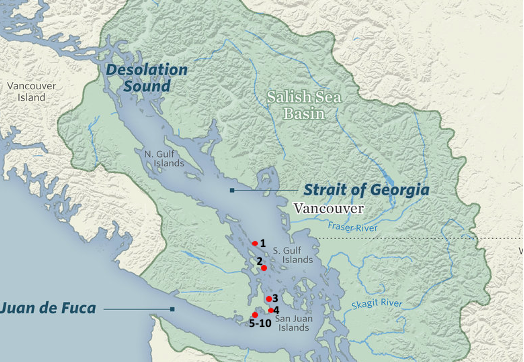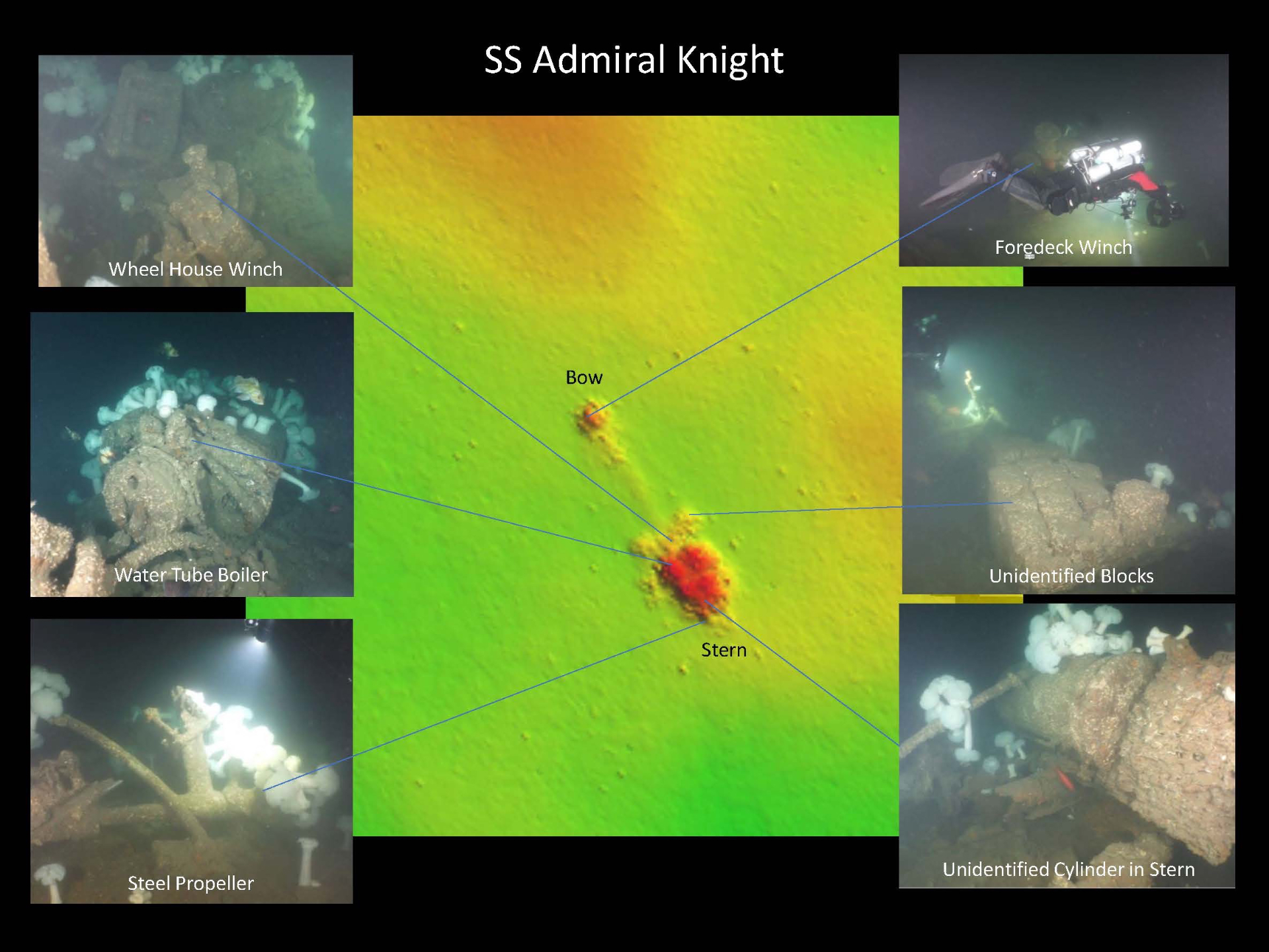Thermocline Exploration: October 18-27, 2024
Ready for some real exploration?
Thermocline has an ambitious schedule for October of 2024! We have two fully equipped dive vessels and a RHIB to work as a combined chase boat and taxi, and a dedicated team of support personnel so it should be an adventure! We will be able to support 10 divers a day on the various sites and locations. The dive sites range from previously explored and documented wrecks where we wish to update their status, to unknown targets that have been on the Underwater Archaeology Society of British Columbia's (UASBC) Wishlist for sometime. We want to provide opportunities for technical divers and recreational divers alike who all share the common goal of exploration and who wish to connect their passion with a purpose.
Divers will be able to join us for part or all of our scheduled program. The exact details of how these dates are going to be broken up will follow later this spring. The important thing is for you to get on the distribution list to be included in updates as we juggle dive sites and dive times that are affected by currents and weather.

How to join us:
We understand that not everyone can take 10 days to dedicate to exploration. We tried to break up our schedule onto bite sized pieces so you can pick and choose when you want to join us. The easiest way to confirm your attendance will be for you to contact Guy at [email protected] and tell him what you wish to do. We will require a non-refundable charter fee deposit but If you can't make it for some reason after you have signed up, its likely we will have a waiting list so if we have someone else to take your space, then we can refund your fees. There are a maximum of 10 spots available for each of the three exploration sections. Once those spaces are filled, we will put names on a waiting list. Once you are signed up, you will start receiving emails with details about the dives. Fees will include a hot lunch between dives. Once we have all the spaces filled, there will be a trip manager for each section that will start working with the divers to develop the diving schedule and what is to be accomplished on each dive. This is true exploration and we will be doing some pretty awesome stuff!
SS Admiral Knight
It was big news when UASBC and GUE divers first found this wreck in the early fall of 2022. One of the first divers on the wreck, Ewan Anderson, wrote a terrific article about the wreck and that article may be found here:
https://gue.com/blog/finding-the-admiral-knight/
Our first trip to the Admiral Knight left us with more questions than answers and we have a lot of work to do on this wreck. Because it is a deeper wreck, our limited time at depth means we need to allow more time overall to generate a good wreck survey. There are parts of this wreck that lend themselves well to photogrammetry and we still don't know what many of the cargo items are on the wreck site. It's an exciting wreck to dive and home to terrific examples of PNW marine life. Because it is all alone on a relatively flat sea floor, it has become an artificial reef of sorts for some truly huge fish! We plan to conduct two days of diving on this wreck.
The Admiral Knight sits in about 190' (57 m) of water so this is a GUE Tech 2 dive or equivalent.
Tell me more about the Admiral Knight!
Mary Hare
The Mary Hare was launched in September of 1893. She was a steam driven, single screw vessel, approximately 73' long and nearly 14' wide. The vessel was named after the daughter of the purchaser, Michael Hare. The Mary Hare was a busy ship and plied the waters of the PNW. The UASBC has been searching for the wreckage of the Mary Hare since 1982 and made several dives along Reid Island. There are records about what happened but the location itself is a bit vague. The plan this time is to use DPV's and a methodical search process to see if we can finally find the wreckage of the Mary Hare. This dive will be in the recreational range and likely less than 70' (21m).

Henry Foss
The Henry Foss is a 100' tugboat originally launched in 1900. She worked in Puget Sound until her loss on February 13, 1959. She sank quickly and with the loss of six crew members. We have the exact location for this wreck and it has been dived by UASBC members several times but the visibility and current can make the dive challenging. It is not considered "deep" by technical diving standards, laying in about 115' of water, but the fact the poor visibility can make it seem deeper. This poor visibility makes this wreck a perfect subject for photogrammetry where we can assemble a collection of images to build a model of the wreck that we would otherwise not be able to see.
The Henry Foss sit in 115' (35m) of water and this places it in the GUE Tech 1 range or equivalent.
Black Dragon
The Black Dragon is one of a series of four migrant ships that travelled from Asia to Vancouver Island, carrying several hundred illegal Chinese migrants. All four ships were apprehended off the BC Coast in 1999. The Black Dragon sits in about 48 meters of water in an area with quite a bit of current and must be dived on the slack. The vessel was under tow when she began to take up water and because it is the only feature in the area, it has become an artificial reef to some of the biggest ling cod around! Some Thermocline members have dived the Black Dragon before and report that it is an excellent dive with a wreck sitting upright and covered with life. It makes for a very cool dive and we don't have very many photos or video of it. We hope to change that!
Because the Black dragon sits in 165' (48 m) of water, this is a solid GUE Tech 1 dive or equivalent.


George McGregor
On November 26th, 1949, The tug George McGregor sunk just off Trial Island with the loss of six of her seven crew members. The 74' tug was originally built in Olympia in 1943 and even worked in Alaska with the United States Maritime Commission. The only survivor was found straddling an overturned life boat near ten mile point. There were originally six sailors on the lifeboat but five of them perished as the life boat was adrift. This was one of the most significant maritime tragedies in the area during that time period and the George McGregor still has not been found and identified for sure. This is high on the UASBC Wishlist and we are going to try really hard to confirm this target is in fact the George McGregor. The currents can be strong in this area and it will required a lot of flexibility with our dive times. This is a Tech 1 dive but the expected conditions will mean the team should be experienced and we will have at least two chase boats to track teams drifting on deco. Adventure!
This is a 155' (47 m) dive which means it is a solid GUE Tech 1 dive or equivalent.

Handley Page Hampden Bomber
The Handley Page Hampden bomber was a twin engine, medium bomber with a crew of 4. They were used for training in the Vancouver Island area and were apparently difficult to fly. The UASBC recently documented a new discovery last year where a Hampden bomber had hit the water just off the shore of Vancouver Island in the Saanich Inlet. We also now have the coordinates for another Hampden bomber that was never salvaged and it is within easy sailing distance of Sidney... can you say "photogrammetry" anyone?...The wreck is within 35-50 m of water so this should give us ample bottom time for some more awesome adventures!

